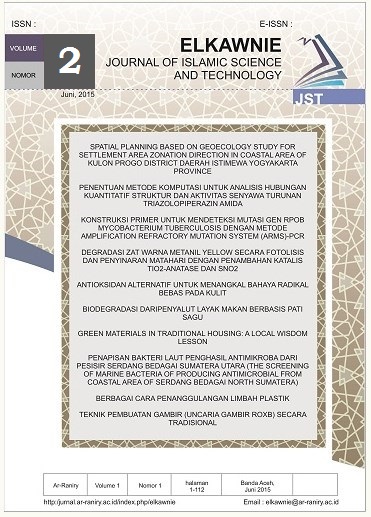Pengaruh Penggunaan Jenis Modulasi Sistem HAPS pada Layanan DVB-T
DOI:
https://doi.org/10.22373/ekw.v2i2.2689Keywords:
DVB-T, HAPS, ModulasiAbstract
DVB-T (Digital Video Broadcasting- Terresrial) merupakan sebuah standar terbuka dalam transmisi video digital yang telah diakui secara internasional dikeluarkan oleh ETSI. Pada penelitian ini akan menganalisis pengaruh pemilihan jenis modulasi yang digunakan terhadap performansi layanan DVB-T pada sistem High Altitude Platforms Station (HAPS). HAPS yang dikenal sebagai stratospheric broadband adalah sebuah standar infrastruktur telekomunikasi yang serupa dengan satellite, yang ditempatkan di lapisan stratosfer. HAPS dikembangkan untuk menjalankan layanan serupa satellite dengan biaya yang lebih hemat, waktu perealisasian yang jauh lebih pendek dan memiliki cakupan yang jauh lebih besar dibandingkan dengan infrastuktur terestial saat ini. Kanal HAPS dapat menyediakan hubungan LOS antara platform HAPS dengan user sehingga dapat disimulasikan dengan kanal rician. Berdasarkan hasil penelitian, performansi layanan DVB-T pada sistem HAPS dipengaruhi oleh jenis modulasi dan mode kerja yang digunakan, penggunaan modulasi QPSK dengan mode kerja 8K memberikan performansi paling baik, dengan memenuhi nilai BER yang telah ditentukan yaitu lebih kecil dari 10-4References
A.Gifson,†High Altitude Platform System sebagai wahana baru dalam telekomunikasi“ 2006.
Alejandro Aragón-Zavala, José Luis Cuevas-RuÃz, and José Antonio Delgado-PenÃn, High-Altitude Platforms for
Wireless Communications, 1st edition, Wiley, December2008.
Brito Luciano, Jose, dkk. “Design, Simulation and Hardware Implementation of a Digital Television System: System Overviewâ€. IEEE Syhmposium on Spread SpectrumTechniques and Application.2006
Cho, Y.S., Kim, J.,Yang, W.Y., Kang, C.G., “ MIMO-OFDM Wireless Communication with Matlabâ€, John Wiley and Son, 2010
ETSI EN 302 307 V1.1.1 (2004-06), “Digital Video Broadcasting (DVB) Second generation framing structure, channel coding and modulation systems for Broadcasting, Interactive Services, News Gathering and other broadband satellite applicationsâ€. 2004-2006
F. Dovis, R. Fantini, M.Mondin, and P. Savi, “ Small-scale fading for high altitude platform (HAP) propagation
channels, “ IEEE J.Sel. Areas Commun., Vol. 20 ,No.3, pp.641-647, April 2002.
Haykin, Simon. “Communication System, 4 Willey, 2001 th Edtionâ€, John-
http://www.capanina .org/
Iskandar, Shigeru Shimamoto, “Channel Characterization and Performance Evaluation of Mobile Communication
Employing Stratospheric Paltformsâ€, IEICE Trans.Communication, vol.E89-B, No.3 March ,2002.
Mohammed Abbas, Asad Mehmood, “ The Role of High Altitude Platforms (HAPs) in the Global Wireless Connectivity †Proceeding of The IEEE 2011
Mustikarani, Jauhar “ Analisis Pengaruh Adaptif Filter Wiener Dalam Meningkatkan Performansi Channel estimation sistem DVB-T †Institut teknologi Telkom 2011
Muquet, B., Biglieri, E., Goldsmith, A., Sari, H. MIMOTechniques for Mobile WiMAX Systems. SEQUANS Communication
Orthogonal Frequency Division Multiplex (OFDM) Tutorial. Charan Langton. 2004 [Internet Draft].
Osvaldo Simeone, “Pilot-Based Channel Estimation forOFDM System by Tracking the Delay-Subspace,†IEEE Trans. Wireless Commun. Vol. 3, No. 1, pp. 315 – 325,
January 2004.
Pertiwi, Devita, “ Analisis Performansi MIMO-OFDM padaSistem HAPS†Institut Teknologi Telkom 2011
Prasad, Ramjee. OFDM for Wireless Communication.Universal Personal Communication. 2004
Rappaport,Theodore S. Wireless Communication, Principleand Practice,second edition. Prentice Hall,Inc.2002.
S.Karapantaziz, F.T Pavlidou,†Broadband Communications Via High Altitude Platforms a Survey†IEEE Commun, Vol7, No.1,2005
Struzak Ryszard, “Mobile telecommunications via stratosphere,†International Communications Project, 2003.
Viswanathan, Mathuranathan, “ Simulation of Digital Communication Systems Using Matlab †Smashwords Edition, 2013.
Downloads
Published
Issue
Section
License
Proposed Policy for Journals That Offer Open Access Authors who publish with the Elkawnie journal agree to the following terms:
a. Authors retain copyright and grant the journal right of first publication with the work simultaneously licensed under a Creative Commons Attribution License that allows others to share the work with an acknowledgement of the work's authorship and initial publication in this journal.
b. Authors are able to enter into separate, additional contractual arrangements for the non-exclusive distribution of the journal's published version of the work (e.g., post it to an institutional repository or publish it in a book), with an acknowledgement of its initial publication in this journal.
c. Authors are permitted and encouraged to post their work online (e.g., in institutional repositories or on their website) prior to and during the submission process, as it can lead to productive exchanges, as well as earlier and greater citation of published work (see The Effect of Open Access).

























